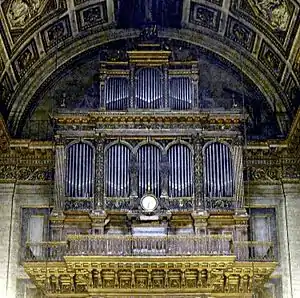Oratorio de Noël
The Oratorio de Noël, Op. 12, by Camille Saint-Saëns, also known as his Christmas Oratorio, is a cantata-like work scored for soloists, chorus, organ, strings and harp. While an organist at La Madeleine, Saint-Saëns wrote the Christmas oratorio in less than a fortnight, completing it ten days before its premiere on Christmas 1858.[1] The vocal score of this oratorio was prepared later by the composer and organist Eugene Gigout, a colleague of Saint-Saëns.
| Oratorio de Noël | |
|---|---|
| Cantata by Camille Saint-Saëns | |
 The Aristide Cavaillé-Coll organ at La Madeleine, where the music premiered | |
| English | Christmas oratorio |
| Catalogue | Op. 12 |
| Text | from the Vulgate |
| Language | Latin |
| Performed | 24 December 1858: Paris |
| Published | 1863 |
| Movements | 10 |
| Scoring |
|
Performing forces
The work is scored for five soloists (soprano, mezzo-soprano, alto, tenor, and baritone), SATB mixed chorus, organ, harp, and strings in the standard five sections. The women of the chorus divide into four parts in one movement. The organ plays a significant role in the work, often playing alone, while the harp is limited to three movements.
Text
Saint-Saëns chose several verses from the Latin Vulgate Bible for the text of the work. "While these texts are not from a single source, it is clear that the traditional church liturgies surrounding Christmas influenced Saint-Saëns. About half of the texts he chose match different portions of two Christmas Offices: the First Mass at Midnight and the Second Mass at Dawn."[2] One author calls the work "a musical enhancement of the words of the [Christmas] Office, without interest in the human drama."[3]
The narrative portion of the text, taken from the second chapter of St. Luke, appears in the second movement and tells the part of the traditional Christmas story involving the shepherds. The remainder of the texts, taken from John, Isaiah, Lamentations, and the Psalms, reflect upon the meaning and significance of the event.
Structure and style
The Oratorio de Noël is structured in a way that "hardly exceeds the limits of a cantata, but musically is constructed in oratorio style."[4] However, "its shorter length and the fact that it was intended for presentation during a worship service place it closer in character and purpose to a traditional sacred cantata."[5] Its structure bears a greater resemblance to oratorios of the early Baroque than to later works of that genre.
Saint-Saëns divided the work into 10 movements, a prelude followed by nine vocal numbers. After the prelude, opening recitatives and chorus, the work gradually builds from a single soloist accompanied by a small ensemble to involve the entire instrumental and vocal forces. The full chorus sings in the second, sixth, and final movements and the women of the chorus accompany the tenor soloist in the fourth.
While there are brief episodes of grandeur in the solo parts and one frenetic section for the chorus, most of the work is subdued and lyrical in character. Saint-Saëns's study of the choral music of Bach, Handel, Mozart, Berlioz, and others had a great influence on the work, with the most significant influences being Part II of J. S. Bach's Christmas Oratorio and Gounod's St. Cecilia Mass.
Movements
- Prélude (dans le style de Seb. Bach), for organ and strings
- Recitative: “Et pastores erant”, for Soprano, Alto, Tenor and Baritone soloists, organ and strings; Chorus: "Gloria in altissimis," for mixed chorus, organ and strings
- Air: "Exspectans expectavi," for Mezzo-soprano soloist, organ and strings
- Air and chorus: “Domine, ego credidi,” for Tenor solo, women's chorus, organ and strings
- Duet: “Benedictus,” for Soprano and Baritone soloists, organ and harp
- Chorus: “Quare fremuerunt gentes,” mixed chorus, organ and strings
- Trio: “Tecum principium,” for Soprano, Tenor, and Baritone soloists, organ and harp
- Quartet: “Laudate coeli,” for Soprano, Mezzo-soprano, Alto, and Baritone soloists, organ and strings
- Quintet and chorus: “Consurge, filia Sion,” for all five soloists, chorus, organ, strings, and harp
- Chorus: “Tollite hostias,” for mixed chorus, organ and strings
Literature
- Music, David W. (1998). "Camille Saint-Saëns's Christmas Oratorio: Description, Accessibility, Comparison". The Choral Journal. American Choral Directors Association. 39 (5): 49–53. ISSN 0009-5028. JSTOR 23552680.
- Barrow, Lee G. (2014). Camille Saint-Saëns, Christmas Oratorio. BarGraphica. ISBN 978-1497393899.
References
- Smither, Howard (2000). Chapel Hill, North Carolina A History of the Oratorio: The Oratorio in the Nineteenth and Twentieth Centuries. UNC Press books, p. 566.
- Barrow, Lee G. (2014). Camille Saint-Saëns, Christmas Oratorio. BarGraphica, p. 33.
- Rees, Brian (1999). Camille Saint-Saëns: a life. London: Chatto & Windus, p. 95.
- Upton, George Putnam (1890). Chicago The Standard Oratorios: Their Stories, Their music, and Their Composers; a handbook, p. 269. A. C. McClurg and Company
- Barrow (2014), p. 70
External links
- Oratorio de Noël: Scores at the International Music Score Library Project
- Oratorio de Noël at AllMusic
